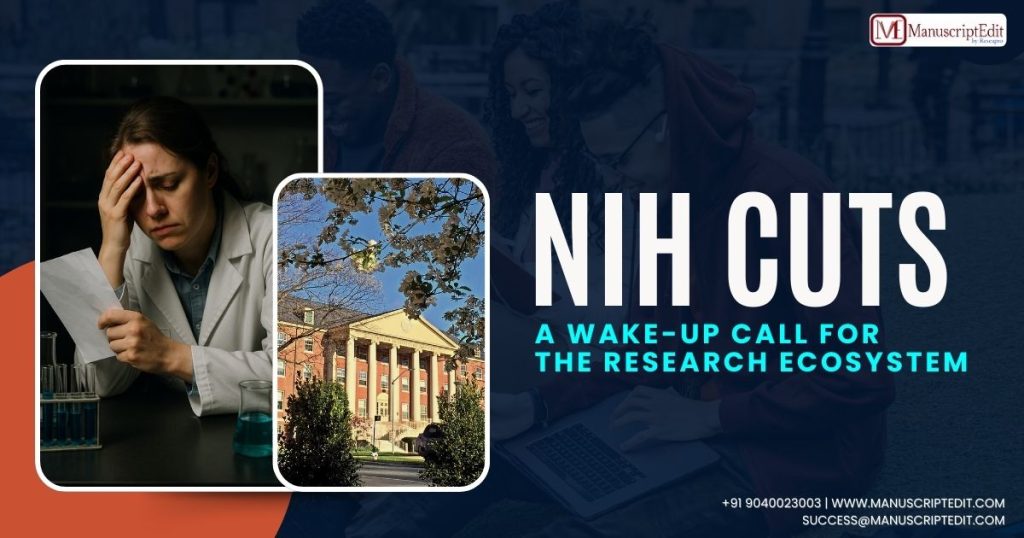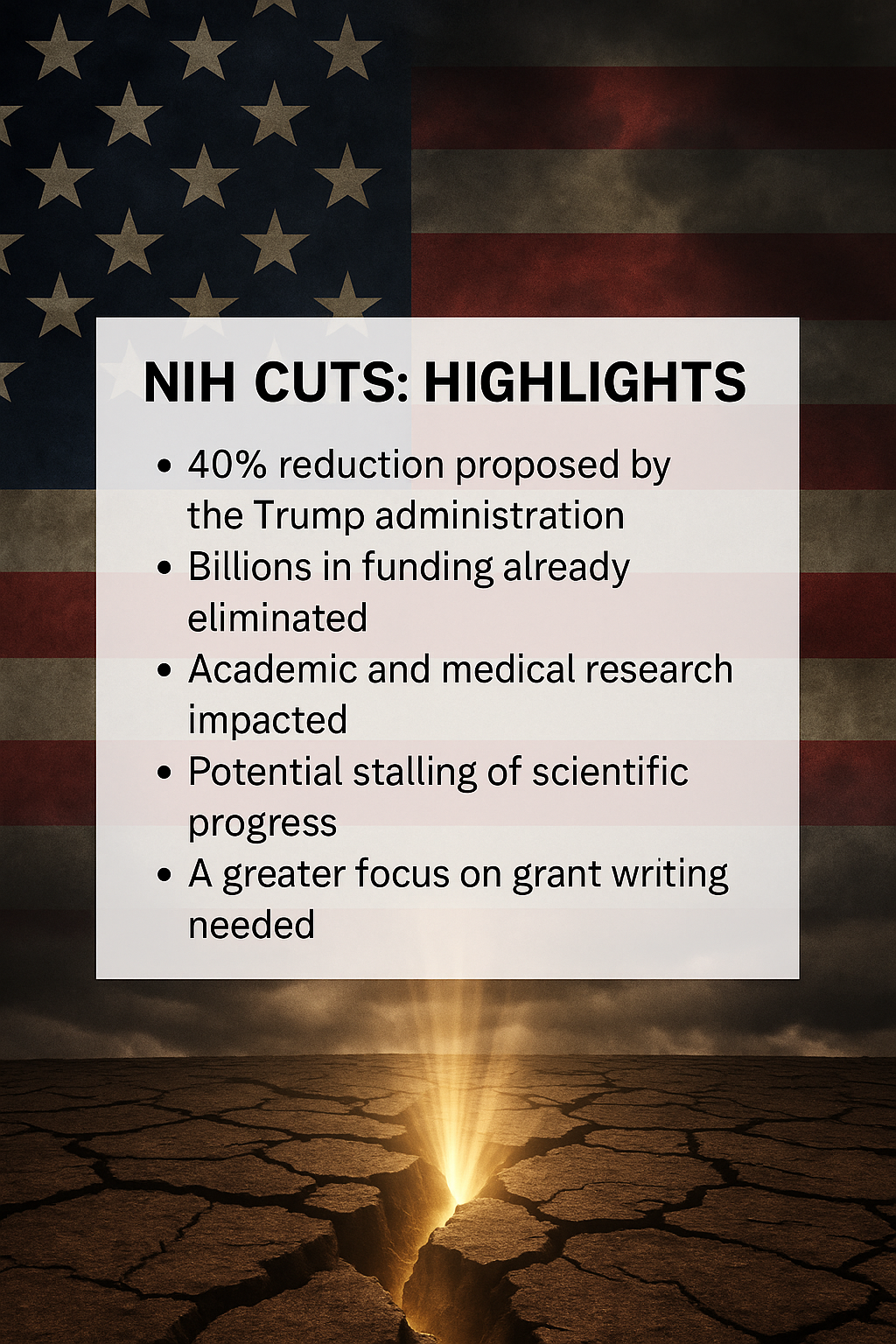
In an unprecedented move that has shocked the scientific community, the National Institutes of Health ( NIH ) canceled over $1.9 billion in research grants in 2025.Consequently, this has tremendously impacted early-career researchers, biomedical innovation, and the US academic ecosystem. The NIH grant cuts of 2025 are not just a bunch of numbers on a spreadsheet; they represent thousands of careers paused, experiments abruptly stopped, and, worst of all, a sense of concerned uncertainty for the very people imagined to be leaders of the next scientific breakthroughs. Now, the question becomes, what happens to science when you have no supportive capacity for its next generation of leaders?
The Fallout: NIH Research Funding Crisis
In Nature’s May 2025 edition (Nature, 2025), it was reported that more than 1,400 grant proposals that had gone through peer review and ultimately had funding were canceled due to last-minute budget insufficiency. These are not low-impact projects but high-impact research on neurodegenerative diseases, cancer, public health, and genomic medicine.The Association of American Universities (AAU) indicates that NIH funding cuts have hit early-career researchers hardest, especially those applying for their first R01 grants or moving from a postdoc position. The funding cuts will slow down the momentum that has been made over the last few years around diversity, equity, and inclusion in science.
Early-Career Researchers: Victims of NIH Budget Cuts
The damage has already been done. Tenure-track assistant professors are scrambling to re-budget, re-structure, or abandon research projects. Inside Higher Ed recently reported that the decision taken by both the NIH and NSF to deprioritize support for early-career scientists has generated a “research bottleneck,” and is producing, as some describe it, a “lost generation of scientists.”For young investigators who have worked for years to build their lab, establish their reputation, and develop their proposal portfolio, losing NIH grants is not just a financial blow but also an emotional and existential tragedy. The loss of grants has knock-on consequences, with most reporting increases in anxiety, burnout, and reconsidering their careers.“It took me 18 months to develop my grant. I was two weeks away from onboarding my first lab technician. Now, I’m back to zero,” said a postdoctoral fellow at a major public university.
The Rise of the Brain Drain
Reduced support from the U.S. federal government has led several early-career scientists to seek positions abroad. According to Business Insider, the trend is accelerating, with researchers moving to Europe, Canada, and Australia, where all forms of public investment in science appear more stable. Interestingly, Germany’s Max Planck Institutes and the European Research Council reported a 35% increase in U.S. applicants since January 2025. Even worse than the loss of talent is the loss of intellectual property and innovation and the further erosion of U.S. global leadership in the biomedical sciences.
Translational Science and Future Costs
One of the most underreported consequences of the science grant eliminations in 2025 is the impact on translational science—that stage we refer to as “the bridge” between the laboratory (bench) and the hospital (bedside). As pointed out in the AAU brief, many of the projects eliminated were also clinical trials in early phases concerning populations with little or no access to justice and in areas of clinical focus, including rare diseases. The ramifications of underserved and/or inadequate funding of translational science will be felt over the next 5 to 10 years as we see a reduction in the number of biomedical therapeutics, delayed diagnostics, and long cycle times for innovation in the U.S. healthcare system.
Academic Publishing Under Pressure
Pressure on Academic Publishing
The NIH funding crisis is also changing academic publishing. Since grants are limited, young scholars publish less, and the quality of journals is lower, partly because there is often no funding for open-access fees or research assistants.Predatory journals have also seen increased submissions from researchers looking to publish to justify their work for promotion and tenure. This raises questions about quality and misinformation.
What Can Early-Career Researchers Do?
Although systematic change requires a national approach, early-career researchers can take individual actions to help weather the NIH budgetary challenges:
1. Diversify funding sources: Think beyond NIH funding sources. Foundations, international consortia, and even private-public partnerships are of growing importance.
2. Build innovative collaborations: Form interdisciplinary and multi-institutional collaborations that strengthen future proposals.
3. Conduct scalable research: Attempt to conduct low-cost, high-impact research, such as research using bioinformatics, modeling, and/or public databases.
4. Think outside the box on dissemination: Utilize preprint servers, public repositories, and open science principles to stay on the map despite possible limitations on publishing.

A Call to Action
The cuts to NIH grants in 2025 are not solely a financial issue; they represent a moral and strategic failure. If America continues on this path, we will lose our next generation of scientists, along with our global leadership in technology, healthcare, innovation, and public confidence in science. We must all act, starting with Congress, to restore and protect science budgets. That said, universities, industry, and senior scholars must work hard to provide mentorship, funds, and advocacy for increasingly marginalized early-career researchers. If there is anything we can learn from this moment, it is that science does not exist in silence. Science requires champions, allies, and some policymakers who believe it has the potential to change the world.
Conclusion
The NIH cuts in grants of 2025 emphasized how precarious the U.S. scientific infrastructure is and serve to highlight those who should be leading our scientific future. For early-career researchers, the answer is unequivocally – adapt, advocate, and align, but do not yield. Science is resilient, but only if we fight for it.



